Ascii Art That Is Stored in an Array of Characters
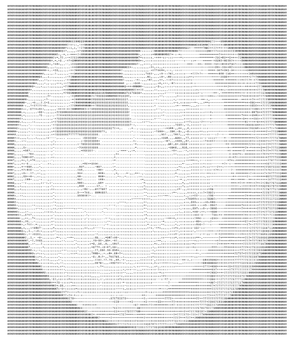
ASCII art version of the Wikipedia logo

"Oldskool" or "Amiga" fashion


"Cake" or "High ASCII" style, cf. ANSI art
![]()
The alphabet in Newskool (Notation: artificially shrunk vertically)

ASCII art is a graphic pattern technique that uses computers for presentation and consists of pictures pieced together from the 95 printable (from a total of 128) characters defined by the ASCII Standard from 1963 and ASCII compliant character sets with proprietary extended characters (beyond the 128 characters of standard vii-scrap ASCII). The term is also loosely used to refer to text based visual art in general. ASCII art tin be created with any text editor, and is often used with free-form languages. Virtually examples of ASCII art require a stock-still-width font (not-proportional fonts, every bit on a traditional typewriter) such as Courier for presentation.
Among the oldest known examples of ASCII art are the creations past computer-art pioneer Kenneth Knowlton from around 1966, who was working for Bell Labs at the time.[1] "Studies in Perception I" by Ken Knowlton and Leon Harmon from 1966 shows some examples of their early ASCII art.[ii]
ASCII art was invented, in large office, considering early printers often lacked graphics power and thus characters were used in place of graphic marks. Also, to marker divisions between unlike print jobs from dissimilar users, majority printers often used ASCII art to impress large banner pages, making the division easier to spot so that the results could be more easily separated by a computer operator or clerk.[three] ASCII art was too used in early east-mail when images could not be embedded.
History [edit]
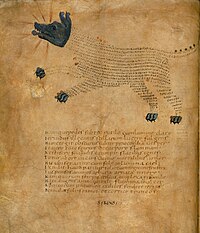
Typewriter art [edit]
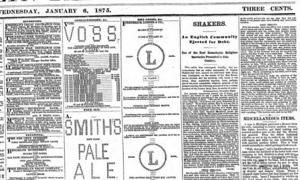
A portion of the Brooklyn Daily Eagle, half-dozen January 1875, showing advertisements made from typewriter fine art.
Since 1867, typewriters have been used for creating visual fine art.[ ameliorate source needed ] [4] [5]
TTY and RTTY [edit]
TTY stands for "TeleTYpe" or "TeleTYpewriter", and is also known as Teleprinter or Teletype. RTTY stands for Radioteletype; character sets such every bit Baudot code, which predated ASCII, were used. Co-ordinate to a chapter in the "RTTY Handbook", text images take been sent via teletypewriter as early as 1923.[six] However, none of the "old" RTTY art has been discovered yet. What is known is that text images appeared frequently on radioteletype in the 1960s and the 1970s.[7] [8]
Line-printer fine art [edit]
In the 1960s, Andries van Dam published a representation of an electronic excursion produced on an IBM 1403 line printer.[ix] At the aforementioned fourth dimension, Kenneth Knowlton was producing realistic images, besides on line printers, by overprinting several characters on peak of one another.[two] Note that it was not ASCII art in a sense that the 1403 was driven by an EBCDIC-coded platform and the grapheme sets and trains available on the 1403 were derived from EBCDIC rather than ASCII, despite some glyphs commonalities.
ASCII art [edit]

There are 95 printable ASCII characters, numbered 32 to 126.
The widespread usage of ASCII art tin can be traced to the calculator message lath systems of the late 1970s and early 1980s. The limitations of computers of that time period necessitated the use of text characters to represent images. Forth with ASCII'southward use in advice, yet, it also began to appear in the underground online art groups of the catamenia. An ASCII comic is a form of webcomic which uses ASCII text to create images. In identify of images in a regular comic, ASCII art is used, with the text or dialog usually placed underneath.[10]
During the 1990s, graphical browsing and variable-width fonts became increasingly popular, leading to a decline in ASCII fine art. Despite this, ASCII fine art continued to survive through online MUDs, an acronym for "Multi-User Dungeon", (which are textual multiplayer office-playing video games), Internet Relay Chat, E-mail, bulletin boards and other forms of online communication which commonly employ the needed fixed-width.[xi]
ANSI [edit]
ASCII and more importantly, ANSI were staples of the early on technological era; final systems relied on coherent presentation using color and control signals standard in the terminal protocols.
Over the years, warez groups began to enter the ASCII art scene.[12] Warez groups usually release .nfo files with their software, cracks or other general software reverse-engineering releases.[13] The ASCII art will usually include the warez group'due south name and mayhap some ASCII borders on the outsides of the release notes, etc.[fourteen]
BBS systems were based on ASCII and ANSI fine art, as were nearly DOS and like console applications, and the precursor to AOL.
Uses [edit]

A tank and truck made using ASCII art
ASCII art is used wherever text can exist more than readily printed or transmitted than graphics, or in some cases, where the manual of pictures is not possible. This includes typewriters, teleprinters, non-graphic computer terminals, printer separators, in early on figurer networking (e.thou., BBSes), electronic mail, and Usenet news letters. ASCII fine art is also used within the source lawmaking of estimator programs for representation of company or product logos, and period control or other diagrams. In some cases, the entire source code of a program is a piece of ASCII art – for instance, an entry to i of the earlier International Obfuscated C Code Contest is a program that adds numbers, only visually looks like a binary adder drawn in logic ports.[15]
Some electronic schematic archives stand for the circuits using ASCII art.[xvi] [17] [eighteen] [19] [20] [21] [22] [23] [24] [25] [26]
Examples of ASCII-style fine art predating the modernistic computer era can be institute in the June 1939, July 1948 and October 1948 editions of Popular Mechanics.[27]
Early on computer games played on terminals frequently used ASCII art to simulate graphics, most notably the roguelike genre using ASCII art to visually represent dungeons and monsters within them.[28] "0verkill" is a 2D platform multiplayer shooter game designed entirely in colour ASCII art. MPlayer and VLC media player can display videos as ASCII art through the AAlib library. ASCII fine art is used in the making of DOS-based ZZT games.
Many game walkthrough guides come every bit function of a bones .txt file; this file often contains the name of the game in ASCII art. Such as below, give-and-take art is created using backslashes and other ASCII values in guild to create the illusion of 3D.
Types and styles [edit]
Different techniques could be used in ASCII art to obtain different artistic effects. Electronic circuits and diagrams were implemented past typewriter or teletype and provided the pretense[ clarification needed ] for ASCII.
"Typewriter-style" lettering, made from individual letter characters:[29]
H H EEEEE L 50 OOO W W OOO RRRR Fifty DDDD !! H H Due east Fifty L O O W W W O O R R L D D !! HHHHH EEEEE Fifty 50 O O Due west W W O O RRRR 50 D D !! H H Eastward L L O O ,, W W O O R R L D D H H EEEEE LLLLL LLLLL OOO ,, Due west W OOO R R LLLLL DDDD !!
Line art, for creating shapes:
.--. /\ ____ '--' /__\ (^._.^)~ <(o.o )>
Solid art, for creating filled objects:
.one thousand@8g. db 'Y8@P' d88b
Shading, using symbols with various intensities for creating gradients or contrasts:
:$#$: "4b. ':. :$#$: "4b. ':.
Combinations of the to a higher place, oft used as signatures, for example, at the stop of an email:
|\_/| **************************** (\_/) / @ @ \ * "Purrrfectly pleasant" * (='.'=) ( > º < ) * Poppy Prinz * (")_(") `>>x<<´ * (pprinz case.com) * / O \ ****************************
case.com) * / O \ **************************** As-pixel characters use combinations of ░ , █ , ▄ and ▀ (Cake Elements) to make pictures:
▄▄▄▄▄▄▄░▄▄▄▄▄▄▄░▄▄▄▄▄▄░▄▄▄▄▄ ░░▀███░░░░▀██░░░░██▀░░░░██░░ ░░░▀██░░░░░▀██░░▄█░░░░░▄█░░░ ░░░░███░░░░░▀██▄█░░░░░░█░░░░ ░░░░░███░░░░░▀██░░░░░░█▀░░░░ ░░░░░░███░░░░▄███░░░░█▀░░░░░ ░░░░░░░██▄░░▄▀░███░░█▀░░░░░░ ░░░░░░░▀██▄█▀░░░███▄▀░░░░░░░ ░░░░░░░░▀██▀░░░░░███░░░░░░░░ ░░░░░░░░░▀▀░░░░░░░▀░░░░░░░░░
Emoticons and verticons [edit]
The simplest forms of ASCII art are combinations of two or three characters for expressing emotion in text. They are usually referred to equally 'emoticon', 'smilie', or 'smiley'. In that location is some other type of one-line ASCII art that does not require the mental rotation of pictures, which is widely known in Japan every bit kaomoji (literally "face characters".)
More complex examples use several lines of text to draw large symbols or more complex figures. Hundreds of different text smileys have adult over fourth dimension,[30] but merely a few are by and large accepted, used and understood.
ASCII comic [edit]
An ASCII comic is a form of webcomic.
The Adventures of Nerd Male child [edit]
The Adventures of Nerd Male child, or just Nerd Male child, was an ASCII comic, published by Joaquim Gândara betwixt 5 August 2001 and 17 July 2007, and consisting of 600 strips. They were posted to ASCII fine art newsgroup alt.ascii-art and on the website.[31] Some strips have been translated to Smoothen[32] [33] and French.
Styles of the computer underground text fine art scene [edit]
Atari 400/800 ATASCII [edit]
The Atari 400/800, which were released in 1979, did non follow the ASCII standard and had their ain character set, called ATASCII.[34] [35] [ failed verification ] The emergence of ATASCII art coincided with the growing popularity of Bbs Systems caused past availability of the audio-visual couplers that were uniform with the 8-bit dwelling house computers. ATASCII text animations are too referred to equally "break animations" by the Atari sceners.[11]
C-64 PETSCII [edit]
The Commodore 64, which was released in 1982, also did not follow the ASCII standard. The C-64 character gear up is called PETSCII, an extended grade of ASCII-1963. As with the Atari's ATASCII art, C-64 fans developed a similar scene that used PETSCII for their creations.
"Block ASCII" / "Loftier ASCII" style ASCII art on the IBM PC [edit]
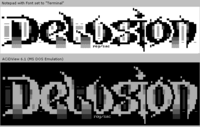
Block ASCII brandish via Notepad versus ACiDView for Windows
And then-called "block ASCII" or "high ASCII" uses the extended characters of the viii-bit code page 437, which is a proprietary standard introduced by IBM in 1979 (ANSI Standard x3.16) for the IBM PC DOS and MS-DOS operating systems. "Block ASCIIs" were widely used on the PC during the 1990s until the Internet replaced BBSes as the main communication platform. Until and so, "block ASCIIs" dominated the PC Text Art Scene.[36] [37]
The first art scene group that focused on the extended character ready of the PC in their art work was called "Aces of ANSI Art" (<A.A.A>). Some members left in 1990, and formed a grouping chosen "ANSI Creators in Demand" (ACiD). In that aforementioned year the second major undercover art scene group was founded, ICE, "Insane Creators Enterprise".[38]
There is some debate between ASCII and block ASCII artists, with "Hardcore" ASCII artists maintaining that cake ASCII art is in fact not ASCII art, because it does not use the 128 characters of the original ASCII standard. On the other manus, block ASCII artists argue that if their art uses only characters of the computers character set, and so information technology is to be chosen ASCII, regardless if the character set is proprietary or non.
Microsoft Windows does non back up the ANSI Standard x3.16. I tin can view block ASCIIs with a text editor using the font "Concluding", merely it will non wait exactly as it was intended by the artist. With a special ASCII/ANSI viewer, such as ACiDView for Windows (see ASCII and ANSI art viewers), i tin can see cake ASCII and ANSI files properly. An example that illustrates the difference in appearance is part of this article. Alternatively, one could look at the file using the TYPE command in the command prompt.
"Amiga"/"Oldskool" style ASCII art [edit]

Oldschool/Amiga ASCII look on Commodore Amiga Calculator versus look on the IBM PC (observe the tight spacing)
In the fine art scene one popular ASCII style that used the 7-bit standard ASCII character set was the so-called "Oldskool" style. Information technology is besides chosen "Amiga manner", due to its origin and widespread use on the Commodore Amiga computers. The style uses primarily the characters: _/\-+=.()<>:. The "oldskool" art looks more similar the outlined drawings of shapes than real pictures. This is an case of "Amiga style" (also referred to as "old school" or "oldskool" style) scene ASCII art.[36]
The Amiga ASCII scene surfaced in 1992, seven years later the introduction of the Commodore Amiga one thousand. The Commodore 64 PETSCII scene did not brand the transition to the Commodore Amiga equally the C64 demo and warez scenes did. Amidst the first Amiga ASCII fine art groups were ART, Epsilon Design, Upper Class, Unreal (later known as "DeZign"). This means that the text fine art scene on the Amiga was actually younger than the text art scene on the PC. The Amiga artists also did not telephone call their ASCII art style "Oldskool". That term was introduced on the PC. When and past whom is unknown and lost in history.
The Amiga style ASCII artwork was most often released in the form of a unmarried text file, which included all the artwork (usually requested), with some blueprint parts in between, as opposed to the PC art scene where the art work was released as a ZIP annal with separate text files for each piece. Furthermore, the releases were usually chosen "ASCII collections" and non "art packs" similar on the IBM PC.
In text editors [edit]
_____ ___ ____ _ _ | ___|_ _/ ___| | ___| |_ | |_ | | | _| |/ _ \ __| | _| | | |_| | | __/ |_ |_| |___\____|_|\___|\__|
This kind of ASCII art is handmade in a text editor. Popular editors used to brand this kind of ASCII art include Microsoft Notepad, CygnusEditor aka. CED (Amiga), and EditPlus2 (PC).
Oldskool font example from the PC, which was taken from the ASCII editor FIGlet.
Newskool style ASCII art [edit]
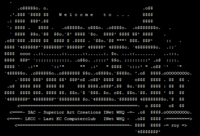
Newskool ASCII screenshot
"Newskool" is a pop form of ASCII art which capitalizes on character strings like "$#Xxo". In spite of its proper name, the style is not "new"; on the opposite, information technology was very old only fell out of favor and was replaced by "Oldskool" and "Block" fashion ASCII fine art. It was dubbed "Newskool" upon its comeback and renewed popularity at the end of the 1990s.[36]
Newskool inverse significantly as the result of the introduction of extended proprietary characters. The classic 7-bit standard ASCII characters remain predominant, but the extended characters are often used for "fine tuning" and "tweaking". The style adult further after the introduction and adaptation of Unicode.
Methods for generating ASCII fine art [edit]
While some adopt to utilize a simple text editor to produce ASCII art, specialized programs, such as JavE have been developed that often simulate the features and tools in bitmap epitome editors. For Block ASCII art and ANSI fine art the creative person almost ever uses a special text editor, because to generate the required characters on a standard keyboard, one needs to know the Alt code for each grapheme. For example, Alt+one 7 8 will produce ▓, Alt+i seven 7 volition produce ▒, and Alt+8 volition produce ◘.
The special text editors have sets of special characters assigned to existing keys on the keyboard. Popular DOS-based editors, such equally TheDraw and ACiDDraw had multiple sets of different special characters mapped to the function keys to make the use of those characters easier for the artist who can switch between individual sets of characters via basic keyboard shortcuts. PabloDraw is one of the very few special ASCII/ANSI art editors that were developed for Windows.
Image to text conversion [edit]
Other programs allow one to automatically convert an prototype to text characters, which is a special case of vector quantization. A method is to sample the epitome down to grayscale with less than 8-bit precision, and then assign a grapheme for each value. Such ASCII art generators often permit users to choose the intensity and contrast of the generated image.[39]
3 factors limit the allegiance of the conversion, especially of photographs:
- depth (solutions: reduced line spacing; bold fashion; cake elements; colored groundwork; expert shading);
- sharpness (solutions: a longer text, with a smaller font; a greater gear up of characters; variable width fonts);
- ratio (solutions with compatibility issues: font with a square grid; stylized without extra line spacing).
Examples of converted images are given below.
This is one of the earliest forms of ASCII fine art, dating back to the early days of the 1960s minicomputers and teletypes. During the 1970s, it was popular in US malls to get a t-shirt with a photo printed in ASCII art on it from an automatic kiosk containing a figurer, and London'south Science Museum had a similar service to produce printed portraits. With the advent of the spider web, HTML and CSS, many ASCII conversion programs volition now quantize to a full RGB colorspace, enabling colorized ASCII images.
Still images or movies can also exist converted to ASCII on various UNIX and UNIX-like systems using the AAlib (blackness and white) or libcaca (colour) graphics device commuter, or the VLC media histrion or mpv nether Windows, Linux or macOS; all of which return the screen using ASCII symbols instead of pixels.[40]
There are likewise a number of smartphone applications, such every bit ASCII cam for Android, that generate ASCII art in real-fourth dimension using input from the phone'south camera. These applications typically allow the ASCII art to be saved every bit either a text file or equally an image made up of ASCII text.
Non stock-still-width ASCII [edit]
Most ASCII art is created using a monospaced font, such as Courier, where all characters are identical in width. Early computers in use when ASCII art came into vogue had monospaced fonts for screen and printer displays. Today, well-nigh of the more unremarkably used fonts in word processors, web browsers and other programs are proportional fonts, such as Helvetica or Times Roman, where different widths are used for different characters. ASCII art drawn for a fixed width font will ordinarily appear distorted, or even unrecognizable when displayed in a proportional font.
Some ASCII artists have produced art for brandish in proportional fonts. These ASCIIs, rather than using a purely shade-based correspondence, use characters for slopes and borders and utilise block shading. These ASCIIs by and large offer greater precision and attention to detail than fixed-width ASCIIs for a lower grapheme count, although they are not every bit universally accessible since they are usually relatively font-specific.
Animated ASCII fine art [edit]
Blithe ASCII art started in 1970 from so-chosen VT100 animations produced on VT100 terminals. These animations were just text with cursor movement instructions, deleting and erasing the characters necessary to appear animated. Ordinarily, they represented a long paw-crafted process undertaken by a unmarried person to tell a story.
Contemporary web browser revitalized animated ASCII fine art again. It became possible to display animated ASCII art via JavaScript or Java applets. Static ASCII art pictures are loaded and displayed one after another, creating the animation, very similar to how movie projectors unreel moving-picture show reel and projection the individual pictures on the large screen at movie theaters. A new term was born: "ASCIImation" – another proper name of animated ASCII art. A seminal work in this arena is the Star Wars ASCIImation.[41] More complicated routines in JavaScript generate more elaborate ASCIImations showing effects like Morphing effects, star field emulations, fading furnishings and calculated images, such as mandelbrot fractal animations.[42] [43]
There are now many tools and programs that can transform raster images into text symbols; some of these tools can operate on streaming video. For example, the music video for American vocalist Brook's song "Black Tambourine"[44] is made up entirely of ASCII characters that approximate the original footage. VLC, a media player software, can render any video in colored ASCII through the libcaca module.
Other text-based visual fine art [edit]
There are a variety of other types of fine art using text symbols from graphic symbol sets other than ASCII and/or some form of color coding. Despite not being pure ASCII, these are yet often referred to equally "ASCII art". The character prepare portion designed specifically for drawing is known as the line drawing characters or pseudo-graphics.
ANSI art [edit]
The IBM PC graphics hardware in text mode uses sixteen bits per character. It supports a variety of configurations, but in its default style nether DOS they are used to give 256 glyphs from one of the IBM PC code pages (Lawmaking page 437 past default), xvi foreground colors, eight groundwork colors, and a flash pick. Such art can be loaded into screen retentiveness directly. ANSI.SYS, if loaded, as well allows such art to be placed on screen by outputting escape sequences that indicate movements of the screen cursor and colour/flash changes. If this method is used then the art becomes known as ANSI art. The IBM PC code pages too include characters intended for simple cartoon which often made this art appear much cleaner than that made with more than traditional character sets. Plain text files are also seen with these characters, though they have become far less common since Windows GUI text editors (using the Windows ANSI code folio) have largely replaced DOS-based ones.
Shift_JIS and Nihon [edit]

Monā ( モナー , Monā ) Posted on 2channel ( 2ちゃんねる , Nichanneru ) in 2000

Gikoneko ( ギコ猫 , Giko cat ) Posted on 2channel ( 2ちゃんねる , Nichanneru ) in 2000
In Japan, ASCII art (AA) is mainly known equally Shift_JIS art. Shift JIS offers a larger selection of characters than obviously ASCII (including characters from Japanese scripts and fullwidth forms of ASCII characters), and may exist used for text-based fine art on Japanese websites.
Oft, such artwork is designed to be viewed with the default Japanese font on a platform, such as the proportional MS P Gothic.[45]
Kaomoji [edit]
Users on ASCII-NET, in which the word ASCII refers to the ASCII Corporation rather than the American Standard Code for Information Interchange, popularised a style of emoticon ( 顔文字 , kaomoji , emoticon) in which the face appears upright rather than rotated.
| Icon | Meaning |
|---|---|
| (^_^) (^^ゞ (^_^;) (-_-;) (~_~;) (・。・;) (・_・;) (・・;) ^^; ^_^; (#^.^#) (^ ^;) | Smiley, nervous, embarrassed, troubled, shy, sweat drop |
Unicode [edit]
Unicode would seem to offer the ultimate flexibility in producing text based art with its huge variety of characters. However, finding a suitable fixed-width font is probable to exist hard if a pregnant subset of Unicode is desired. (Mod UNIX-manner operating systems do provide complete fixed-width Unicode fonts, east.g. for xterm. Windows has the Courier New font, which includes characters like ┌╥─╨┐♥☺Ƹ̵̡Ӝ̵̨̄Ʒ). Likewise, the common practise of rendering Unicode with a mixture of variable width fonts is likely to make anticipated display hard, if more than a tiny subset of Unicode is used. ≽ʌⱷ҅ᴥⱷʌ≼ is an acceptable representation of a cat's face in a font with varying character widths.
Control and combining characters [edit]
The combining characters mechanism of Unicode provides considerable means of customizing the style, even obfuscating the text (east.g. via an online generator like Obfuscator,[46] which focuses on the filters[47]). Glitcher is one example of Unicode fine art, initiated in 2012: These symbols, intruding upward and down, are fabricated by combining lots of diacritical marks. Information technology's a kind of art. In that location'due south quite a lot of artists who use the Internet or specific social networks as their canvass. [48] The respective creations are favored in web browsers (thanks to their always better support[49]), as geekily stylized usernames for social networks. With a off-white compatibility, and amid dissimilar online tools, [Facebook symbols] [fifty] showcases various types of Unicode art, mainly for aesthetic purpose (Ɯıḳĭƥḙȡḯả Wîkipêȡıẚ Ẉǐḳîṗȅḍȉā Ẃįḵįṗẻḑìẵ Ẉĭḵɪṕḗdïą Ẇïƙỉpểɗĭà Ẅȉḱïṕȩđĩẵ etc.). Too, the creations can be hand-crafted (by programming), or pasted from mobile applications (eastward.1000. the category of 'fancy text'[51] tools on Android). The underlying technique dates dorsum to the old systems that incorporated control characters, though. E.g. the High german composite ö would be imitated on ZX Spectrum by overwriting[52] " afterwards backspace and o.
Overprinting (surprint) [edit]
In the 1970s and early 1980s information technology was popular to produce a kind of text art that relied on overprinting. This could be produced either on a screen or on a printer past typing a graphic symbol, backing upward, so typing another graphic symbol, just equally on a typewriter. This developed into sophisticated graphics in some cases, such equally the PLATO organization (circa 1973), where superscript and subscript allowed a wide multifariousness of graphic effects. A common use was for emoticons, with WOBTAX and VICTORY both producing convincing smiley faces.[53] Overprinting had previously been used on typewriters, simply the low-resolution pixelation of characters on video terminals meant that overprinting here produced seamless pixel graphics, rather than visibly overstruck combinations of letters on paper.
Beyond pixel graphics, this was also used for printing photographs, as the overall darkness of a detail graphic symbol space dependent on how many characters, as well as the choice of graphic symbol, were printed in a particular place. Thanks to the increased granularity of tone, photographs were often converted to this type of printout. Fifty-fifty transmission typewriters or daisy wheel printers could exist used. The technique has fallen from popularity since all cheap printers can easily print photographs, and a normal text file (or an electronic mail bulletin or Usenet posting) cannot represent overprinted text. Even so, something similar has emerged to replace it: shaded or colored ASCII art, using ANSI video final markup or colour codes (such as those constitute in HTML, IRC, and many cyberspace message boards) to add a bit more tone variation. In this way, information technology is possible to create ASCII art where the characters simply differ in color.
Run across also [edit]
- Micrography
- Types and styles: Alt code, ASCII stereogram, box-drawing characters, emoticon, FILE ID.DIZ, .nfo (release info file)
- Pre-ASCII history: Calligram, Concrete verse, Typewriter, Typewriter mystery game, Teleprinter, Radioteletype
- Related art: ANSI art, ASCII porn, ATASCII, Fax art, PETSCII, Shift JIS fine art, Text semigraphics
- Related context: Bulletin lath organisation (BBS), Computer art scene, Category:Artscene groups
- Software: AAlib, cowsay
- Unicode: Homoglyph, Duplicate characters in Unicode
References [edit]
- ^ Carlson, Wayne Eastward. (2003). "An Historical Timeline of Computer Graphics and Animation". Archived from the original on 2008-03-ten. Retrieved 2008-03-05 .
- ^ a b Carlson 2003 "1966 Studies in Perception I by Ken Knowlton and Leon Harmon (Bell Labs)", Prototype of Studies in Perception I Archived 4 March 2016 at the Wayback Machine
- ^ Moritsugu, Steve (2000). Practical UNIX . Que Publishing. pp. 220–221. ISBN9780789722508.
banner.
- ^ Stark, Joan G. (2001). "The History of ASCII (Text) Art". Archived from the original on 2009-10-26. Retrieved 2008-03-05 .
- ^ Robert, Paul (2005-05-11). "Typewriter Art". The Virtual Typewriter Museum. Retrieved 2008-03-05 .
- ^ Green, Wayne (June 1972). RTTY Handbook. Blueish Ridge Summit, Pennsylvania: K/L Tab Books. ISBN0-8306-2597-six.
- ^ Stark, Joan G. (2000). "DEVELOPMENT OF (ASCII) TEXT Fine art". Archived from the original on 2009-10-26. Retrieved 2008-03-05 .
- ^ "New Folio". world wide web.rtty.com . Retrieved 2017-10-19 .
- ^ "A compact data structure for storing, retrieving and manipulating line drawings" by Andries Van Dam & David Evans
- ^ Chute, Hillary L.; Jagoda, Patrick (2014-07-11). Comics & Media: A Special Issue of "Critical Enquiry". Academy of Chicago Printing. ISBN978-0-226-23908-viii.
- ^ a b Untitled. webcache.googleusercontent.com. ISBN978-i-283-48829-seven . Retrieved 2020-05-07 .
- ^ Necromancer (1998-03-06). "History of the PC Ascii Scene". textfiles.com. Archived from the original on 2008-02-15. Retrieved 2008-03-05 .
- ^ Defacto2 (2008). "Defacto2 – Scene Documents, text and NFO files". defacto2.net. Archived from the original on 2008-03-12. Retrieved 2008-03-05 .
- ^ NFO Files collection at Defacto2.cyberspace, with NFO files that date back to 1989. Retrieved 17 February 2008.
- ^ Downs, Makarios. "16 bit add-on the like shooting fish in a barrel/hard way".
- ^ "Document Markup Format". Archived from the original on 2004-06-26.
- ^ "Circuits Archive"
- ^ "Sci.electronics FAQ: Contrasted ASCII Schematics". www.repairfaq.org.
- ^ Cunningham, Collin (2010-02-04). "Schematics just await cooler in ASCII". Make:. Archived from the original on 2016-09-11.
- ^ "ASCII Circuits"
- ^ Paul, Matthias R. (2005-12-12). "Minolta SR-T Batterieadapter" [Using a Bandgap voltage reference equally Mercury battery replacement]. Minolta-Forum (in German). Archived from the original on 2016-10-xi. Retrieved 2011-02-26 .
- ^ Paul, Matthias R. (2009-03-14). "Minolta SR-T Batterieadapter" [Using a seven×7 mm SMD transistor-based low-side voltage regulator excursion as Mercury battery replacement]. Minolta-Forum (in German). Archived from the original on 2016-03-27. Retrieved 2011-02-26 .
- ^ Paul, Matthias R. (2005-03-07). "Eigenbau eines Kabelauslösers - Problem mit der Funktion…" [Building your own remote camera trigger - problem with function…]. Minolta-Forum (in German). Archived from the original on 2016-03-31. Retrieved 2016-03-31 .
- ^ Paul, Matthias R. (2009-04-26) [2007-11-01]. "Funkblitzauslöser PT-04 m. Minolta-Blitz 5600HS(D) - Funkauslöser funktioniert, aber Blitz löst trotzdem nicht aus" [Wireless remote flash control PT-04 with Minolta flash 5600HS(D) - wireless triggering works, but all the same flash does not fire]. Minolta-Forum (in German language). Archived from the original on 2016-06-06. Retrieved 2016-06-06 .
- ^ Paul, Matthias R. (2010-04-09) [2009-04-17]. "Auto-Off-Deaktivierung bei Minolta Programme 4000 AF - Automatische Abschaltung des 4000 AF für Slave-Betrieb deaktivieren?" [Deactivating auto-off function of Minolta Program 4000 AF]. Minolta-Forum (in German). Archived from the original on 2016-03-27. Retrieved 2016-03-27 .
- ^ Paul, Matthias R. (2012-05-09). "Innenschaltung Minolta PC Concluding Adapter PCT-100" [Internal circuitry of Minolta PC Terminal Adapter PCT-100]. Minolta-Forum (in German language). Archived from the original on 2016-08-04. Retrieved 2016-08-04 .
- ^ Cumbrowski, Carsten (2007-02-14). "Keyboard Text Art From Over Xx Years Before ASCII". roysac.com . Retrieved 2008-03-05 .
- ^ Valentin, Christian (2016-ten-17). "Roguelikes Aren't Done With ASCII Fine art Nonetheless". Kill Screen . Retrieved 2020-01-04 .
- ^ Paul, Matthias R. (1997-07-30) [1994-05-01]. NWDOS-TIPs – Tips & Tricks rund um Novell DOS 7, mit Blick auf undokumentierte Details, Bugs und Workarounds [NWDOS-TIPs - — Tips & tricks for Novell DOS 7, with a focus on undocumented details, bugs and workarounds]. MPDOSTIP. Release 157 (in German) (iii ed.). Archived from the original on 2017-09-10. Retrieved 2014-08-06 . (NB. The top of the NWDOSTIP.TXT file shows a large text logo in typewriter-manner art.) [1]
- ^ textfiles (2008). "Collection of ASCII Smileys". Archived from the original on 2008-03-10. Retrieved 2008-03-05 .
- ^ Gândara, Joaquim (2006). "The Adventures of Nerd Boy—Episodes one-635". Nerd-Boy.net. Retrieved 2008-03-05 .
- ^ Wilk 2006 episodes 1 to 172
- ^ nb-pl.jogger.pl 2006 episodes 208 to 470
- ^ Štěrba, Radek (2005-12-xx). "ATASCII". Archived from the original on 2005-12-20. Retrieved 2005-12-20 . (gif image)
- ^ Moeser, David; Fusik, Piotr (2007-05-xiii). "7.ii: What is the ATASCII character set?". faqs.org. Retrieved 2008-03-05 .
- ^ a b c Roy/SAC. "The 3 ASCII Fine art Styles of the Undercover Text Art Scene". www.roysac.com . Retrieved 2017-10-19 .
- ^ An Abbreviated History of the Underground Estimator Art Scene by Napalm, 11 Oct 1998, The History of Art and Technology
- ^ 100 YEARS OF THE COMPUTER ART SCENE, Presented past Jason Scott Sadofsky and RaD Man (Acrid), Notacon Conference – Cleveland, Ohio, United states of america, 23–25 April 2004.
- ^ "ASCII Art Generator: An Overview". asciiartgenerator.cyberspace. 2012-01-12. Archived from the original on 2013-08-01. Retrieved 2012-03-19 .
- ^ "54. Sentinel Videos in ASCII Art - Linux Multimedia Hacks [Book]". www.oreilly.com.
- ^ Jansen, Simon (2006-04-18). "Star "ASCIImation" Wars". Asciimation.co.nz. Archived from the original on 2008-12-09. Retrieved 2008-11-18 .
- ^ ASCII Animation "Morph" by SkyLined (using JavaScript) includes morph furnishings and mandelbrot fractal animation
- ^ ASCII Animation Starfield by SkyLined (using JavaScript) includes fading consequence and horizontal scrolling star field emulation
- ^ BeckVEVO (2009-10-07). "Brook - Blackness Tambourine". Retrieved 2017-10-19 – via YouTube.
- ^ "Mona Font". monafont.sourceforge.net . Retrieved 2017-ten-19 .
- ^ "Online Text Obfuscator". obfuscator.uo1.net.
- ^ "web services - Should Unicode exist allowed in usernames?". Stack Overflow.
- ^ Zakas, Laimonas. "Facebook Folio Performance Art Glitchr". TechCrunch. AOL. Retrieved 2015-06-23 .
- ^ "Unicode 3.2 test page". world wide web.ltg.ed.ac.united kingdom of great britain and northern ireland.
- ^ "Facebook profile name style with symbols (fb proper noun font generator)". fsymbols.com.
- ^ "fancy text - Android Apps on Google Play". play.google.com.
- ^ "Globe of Spectrum - Documentation - ZX Spectrum manual - Chapter 16". www.worldofspectrum.org.
- ^ PLATO Emoticons, revisited, Brian Love, PLATO History: Remembering the hereafter, xix September 2012
Further reading [edit]
- Beal, Vangie (2008). "Text Messaging Abbreviations: A Guide to Understanding Online Chat Acronyms & Smiley Faces". Webopedia. Archived from the original on 2008-03-06. Retrieved 2008-03-05 .
- Carlsson, Anders; Miller, A. Bill (2012). "Future Potentials for ASCII art". Archived from the original on 2014-07-08. Retrieved 2014-07-08 .
- Cumbrowski, Carsten (2007-eleven-02). "History of Text Art Video by RaD Man / Acid". roysac.com. Archived from the original on 2008-03-02. Retrieved 2014-03-29 .
- Jones, Mike (2002-09-12). "The First Smiley :-)". Microsoft Inquiry. Archived from the original on 2008-03-05. Retrieved 2008-03-05 .
- nb-pl.jogger.pl (2006). "[ Nerdboy PL ]". Archived from the original on 2006-05-fourteen. Retrieved 2006-05-14 . (Polish translators: Ania Górecka [ag], Asia Mazur [as], Błażej Kozłowski [bug], Janusz [jp], Łukasz Dąbrowski [luk], Łukasz Tyrała [lt.], Łukasz Wilk [wilu], Marcin Gliński [fsc])
- Wilk, Łukasz (2006). "Strona grupy dyskusyjnej PL.REC.ASCII-ART" (in Polish). Archived from the original on 2006-01-fifteen. Retrieved 2006-11-thirty .
- Wirth, Christian (2007). Building Grapheme: ANSI From the Ground Up. Notacon. Retrieved 2013-07-07 .
External links [edit]
| | Wikimedia Eatables has media related to ASCII art. |
- ASCII art at Curlie
- media4u.ch - ASCII Art (ASCII Art Motion-picture show. The Matrix in ASCII Art)
- TexArt.io ASCII Art collection
- Textfiles.com annal
- 16 Colors ANSI Art and ASCII Art Archive
- Defacto2.net Scene NFO Files Archive
- Chris.com ASCII fine art drove
- "As-Pixel Characters" ASCII art collection
- ASCII Art Animation of Star Wars, "ASCIIMATION"
- ASCII Keyboard Art Drove
- Animasci
Source: https://en.wikipedia.org/wiki/ASCII_art
0 Response to "Ascii Art That Is Stored in an Array of Characters"
Post a Comment